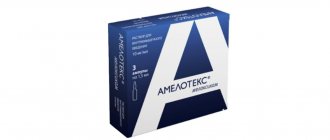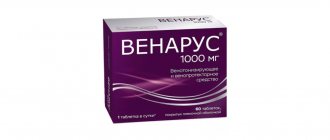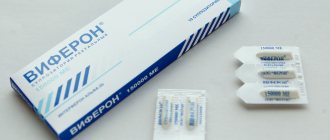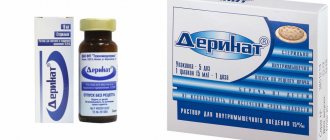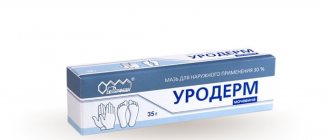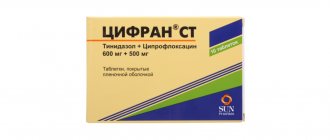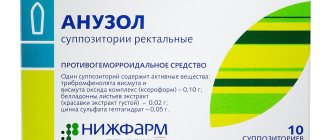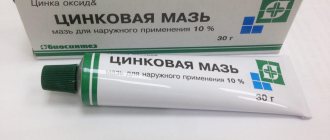Ulcerative lesions of the stomach and intestines lead to discomfort and digestive disorders, and the appearance of heartburn. Many drugs effectively relieve only the symptoms of the disease. In contrast, Kvamatel acts specifically on the cause of the pathology. Therefore, the drug gives real therapeutic results in a relatively short time.
Compound
One coated tablet contains 20 mg of the main substance famotidine and auxiliary components: lactose monohydrate, povidone K90, colloidal silicon dioxide, corn starch, magnesium stearate, talc, sodium carboxymethyl starch.
One bottle of the drug in the form of a lyophilized powder, from which an injection solution is prepared, contains 20 mg of the main substance famotidine . The auxiliary component is a solution of sodium chloride 0.9% in a 5 ml ampoule.
Pharmacodynamics and pharmacokinetics
This drug, acting on the walls of the stomach, helps to effectively reduce the production of gastric juice, reducing its volume. At the same time, the evacuation function of the stomach, blood circulation in the liver, secretory function of the pancreas, and so on do not change.
The dosage form Kvamatel Mini is also used to treat ulcerative lesions of the stomach and duodenum. The main indication for taking tablets is heartburn . This not only eliminates unpleasant symptoms, but also prevents excessive production of hydrochloric acid. Therefore, Kvamatel Mini helps eliminate heartburn and prevents the development of peptic ulcers.
To achieve a therapeutic effect lasting 10-12 hours, a single dose of the drug at a dosage of 20-40 mg may be sufficient. If you take 10 mg, its effect will last about 9 hours. The drug is absorbed in the gastrointestinal tract, metabolized in the liver, excreted by the kidneys, a small part - in the form of metabolites, and mostly unchanged.
"Kvamatel": composition, description
The drug is available in the form of tablets and lyophilized powder, on the basis of which an aqueous solution for injection is made (administered intravenously). The active ingredient is famotidine. Auxiliary compounds - silicon dioxides, lactose in the form of monohydrate, talc and others. Each tablet and each bottle of powder contains a single dose of the active substance in the amount of 20 mg.
Each pack contains 14 pcs. tablets. The powder is produced in small bottles of 5 pieces. packaged. They also come with a physiological solution of sodium chloride with a concentration of 0.9% (volume of 1 ampoule - 5 ml).
The product is characterized by antiulcer effects. The active component affects the walls of the stomach, reduces the secretion of gastric juice, the most important component of which is hydrochloric acid. Moreover, this does not affect other digestive organs, including the liver and pancreas.
Today the drug is available in 2 dosage forms:
- "Kvamatel" (20 mg of active ingredient in 1 tablet).
- "Kvamatel Mini" (10 mg of active ingredient in 1 tablet).
Both drugs have the same active ingredient and are used to treat ulcerative lesions of the gastrointestinal tract. Moreover, Kvamatel Mini tablets are also used for heartburn. Moreover, it eliminates not only the symptoms, but the causes of the disease.
The therapeutic effect lasts for 10-12 hours. To improve your well-being, a single dose is enough. The active substances are absorbed through the walls of the small intestine and utilized in the liver. They are excreted in the urine mainly in chemically unchanged form.
Contraindications for use
- lactation, pregnancy;
- childhood;
- intolerance to the drug and other histamine H2 receptor blockers.
Particular care is required when treating patients with Kvamatel who suffer from renal or liver failure , liver cirrhosis , accompanied by portosystemic encephalopathy .
Indications and contraindications
The product is used in the presence of such diseases:
- ulcerative lesions of the stomach and/or duodenum (the drug is used to prevent relapse, as well as during exacerbation);
- gastroduodenitis of erosive type;
- prevention and treatment of damage to the gastrointestinal tract of various origins;
- prevention and treatment of uncomplicated stages of pathologies.
In some cases, the drug cannot be taken
- children under 17 years of age inclusive;
- pregnancy period;
- breastfeeding period;
- individual intolerance to the main or additional components, allergic reactions.
The drug should be used with caution in the presence of kidney and liver diseases, including cirrhosis.
Side effects
Treatment with Kvamatel can lead to the development of various undesirable reactions in the body. Deviations in the functions of the gastrointestinal tract occur especially often: nausea , vomiting , problems with stool, loss of appetite , impaired liver function , dry mouth.
The nervous, hematopoietic and cardiovascular systems often suffer, which is manifested by: headache, dizziness , high fatigue, anxiety, heart rhythm disturbances, leukopenia , thrombocytopenia and so on. Allergic reactions may also develop, body temperature may rise, muscle or joint pain, gynecomastia , and more may occur. If any unwanted effects occur, you should consult a specialist.
Kvamatel, instructions for use (Method and dosage)
Despite the fact that the indications for the use of Kvamatel include various gastrointestinal diseases associated with ulcerative lesions, when starting treatment it is necessary to exclude malignancy of the ulcer .
An injection solution prepared from lyophilized powder is used strictly for intravenous administration in a hospital setting. The medicine is prepared from powder in a bottle, mixed with a solvent from an ampoule. When the powder is completely dissolved, the product is slowly injected into a vein over 2 minutes.
In addition, intravenous infusion of Kvamatel is possible. To do this, the powder is dissolved in 5 ml of sodium chloride 0.9% and mixed with the infusion solution. The period of this type of administration can be 15-30 minutes.
The drug in tablets should be taken without crushing or chewing, with plenty of liquid. The dosage and duration of therapy is determined by the attending physician for each patient.
This also applies to Kvamatel Mini tablets. However, in most cases, adult patients suffering from heartburn caused by high acidity need to take 1 tablet daily. To prevent heartburn and postprandial symptoms, one tablet is also prescribed one hour before meals. You can take no more than 2 tablets per day.
Continuous treatment should not exceed a course of 2 weeks. If after 7 days of therapy the symptoms do not disappear, you should urgently visit your doctor - undergo a re-examination and receive a new treatment prescription.
Use of the drug Kvamatel tablets
Peptic ulcer of the duodenum: 40 mg once before bedtime or 20 mg 2 times a day (morning and evening). The duration of treatment is usually 4–8 weeks. As monotherapy in the absence of H. pylori or as part of combination therapy. Peptic ulcer: 40 mg once daily for 4–8 weeks. As monotherapy in the absence of H. pylori or as part of combination therapy. Gastroesophageal reflux disease: 20 mg 2 times a day in the morning and evening for 6 weeks, in the presence of esophagitis - 20–40 mg for 12 weeks. Zollinger-Ellison syndrome: for patients who have not previously received therapy, the usual initial dose is 20 mg of the drug every 6 hours. Subsequently, the dose is set individually depending on the patient's condition. For patients who have previously received another H2 blocker drug, the initial dose of famotidine may be higher than 20 mg every 6 hours. The duration of use of the drug should be clinically justified. To prevent relapse of peptic ulcers of the stomach and duodenum: 20 mg once before bedtime. Before general anesthesia in order to prevent aspiration of gastric contents: 40 mg is prescribed the night before and/or in the morning of the day of surgery. Use in certain groups of patients : Renal failure. Due to the fact that Kvamatel is excreted mainly by the kidneys, in the presence of severe kidney disease, the drug is recommended to be used with caution. With a creatinine clearance of 30 ml/min or a serum creatinine level of 3 mg/100 ml, the daily dose of the drug should be reduced by 20 mg or the interval between doses should be increased (36–48 hours). Use in childhood. There is insufficient data on the safety and effectiveness of Kvamatel in children. Elderly patients. There is no need to adjust the dose of Kvamatel depending on the age of the patient.
Interaction
Kvamatel does not affect the biotransformation of drugs whose metabolism is related to the cytochrome P450 .
Concomitant use with Ketoconazole may reduce its absorption by changing the pH formula of gastric juice.
A decrease in the absorption of famotidine was noted when the drug was combined with antacid drugs .
Combined use with drugs containing probenecid reduces the excretion of famotidine .
Pharmacological properties of the drug Kvamatel tablets
Famotidine is an effective competitive blocker of H2-histamine receptors in the stomach wall, and therefore reduces the secretion of gastric juice. Under the influence of the drug, both the concentration and the amount of gastric juice decreases, and the secretion of pepsin corresponds to the released amount of gastric juice. Both in healthy volunteers and in patients with increased secretion, famotidine equally reduces gastric secretion - both basal nocturnal and stimulated by pentagastrin, betazol, caffeine, insulin or stimulation of the vagus nerve. The effect of 20 and 40 mg of famotidine lasts 10–12 hours. A single evening dose (20–40 mg) reduces basal and nocturnal secretion of gastric juice. The degree of blocking the secretion of gastric juice at night is 86–94% and lasts at least 10 hours. When using the same dose in the morning, the degree of blocking the secretion of gastric juice stimulated by food within 3–5 hours is 76–84%, and after 8–10 hours - 25–30%. The drug has virtually no effect on either the “hungry” level of gastrin or its level after a meal. Famotidine has no effect on gastric emptying, pancreatic secretory function, hepatic circulation and portal blood flow. Famotidine does not affect the liver cytochrome P450 enzyme system, the level of hormones in the blood serum, and does not have an antiandrogenic effect. Pharmacokinetics. The pharmacokinetic profile of famotidine is linear. Absorption: famotidine is absorbed quickly and completely. Bioavailability of 40–45%, regardless of stomach contents, does not change with age. The bioavailability of famotidine is slightly affected by first-pass metabolism. Distribution in the body: after oral administration, the maximum concentration of famotidine in the blood plasma is observed after 1–3 hours. Repeated doses do not lead to the accumulation of the drug. The connection with blood plasma proteins is insignificant - 15–20%. The half-life from blood plasma is 2.3–3.5 hours. In the presence of severe renal failure, the half-life may increase by 20 hours. Metabolism: metabolized in the liver, the only known metabolite is sulfoxide. Excretion: Renal clearance is 250–450 ml/min, indicating tubular excretion. 25–30% of the dose taken orally is excreted unchanged in the urine, only a small amount of famotidine is excreted as sulfoxide.
Analogues of Kvamatela
Level 4 ATC code matches:
Gastrosidine
Gistak
Ranitidine
Acylok
Cimetidine
Zantac
Famotidine
Drugs with similar effects include:
- Gasterogen;
- Famotidine;
- Famotel;
- Pepsidin;
- Famosan;
- Gastrosidin.
Reviews about Kvamatel
Numerous reviews of Kvamatel confirm its effectiveness, since as a result of treatment: pain disappears, the functioning of the digestive system improves, and so on. At the same time, some users are interested in what Kvamatel tablets help best with, and what form should be used for severe disorders. In response, experts advise visiting a gastroenterologist and finding out everything after the examination.
However, there are reports when patients say that treatment with Kvamatel did not help them. Moreover, additional problems appeared in the gastrointestinal tract.
Therefore, it is recommended to take treatment with Kvamatel seriously and not use it without a doctor’s prescription for attacks of heartburn or stomach pain, since taking it requires an accurate diagnosis.
Kvamatela price, where to buy
In pharmacies in Moscow and some Russian cities, the price of Kvamatel varies between 119-450 rubles.
In Ukraine, this drug can be purchased in a variety of forms at a cost of 39-179 UAH.
- Online pharmacies in RussiaRussia
- Online pharmacies in UkraineUkraine
- Online pharmacies in KazakhstanKazakhstan
ZdravCity
- Kvamatel tablets p.p.o.
20 mg 28 pcs. JSC Gedeon Richter 135 rub. order - Kvamatel tablets p.p.o. 40 mg 14 pcs. JSC Gedeon Richter
117 RUR order
Pharmacy Dialogue
- Kvamatel (tab.p.pl/vol. 40 mg No. 14)Gedeon-Richter
115 rub. order
- Kvamatel (tab.p.pl/vol. 20 mg No. 28) Gedeon-Richter
130 rub. order
- Kvamatel (flask 20 mg No. 5+sol.)Gedeon-Richter
RUB 273 order
show more
Pharmacy24
- Kvamatel 20 mg N5 lyophilisate + solvent 5 ml N5
303 UAH.order - Kvamatel 20 mg No. 28 tablets VAT "Gedeon Richter", Ugorshchina
145 UAH order
- Kvamatel 40 mg No. 14 tablets VAT "Gedeon Richter", Ugorshchina
137 UAH order
PaniPharmacy
- Kvamatel bottle Kvamatel Liof. por. d/in. 20mg amp. 5ml No. 5 Hungary, Gedeon Richter
304 UAH order
- Kvamatel tablets Kvamatel tablets. 20 mg No. 28 Hungary, Gedeon Richter
155 UAH order
- Kvamatel tablets Kvamatel tablets. 40 mg No. 14 Hungary, Gedeon Richter
131 UAH order
show more
Special instructions for the use of the drug Kvamatel tablets
Before starting therapy, it is necessary to exclude malignancy of the ulcer by morphological examination of a biopsy from the ulcer area. For severe liver diseases, the drug is used with extreme caution in reduced doses. Due to the fact that a cross-allergic reaction has been described between various drugs of the H2-blocker group, in the presence of hypersensitivity to another drug in this group, Kvamatel should be used with caution. If you are lactose intolerant, please note that each 20 mg tablet of famotidine contains 105 mg of lactose, and each 40 mg tablet contains 90 mg of lactose. Famotidine passes into breast milk, so if it is necessary to use it during breastfeeding, breastfeeding should be discontinued. There is no data on the effect of the drug on the ability to drive vehicles or perform work that requires concentration and increased attention.
